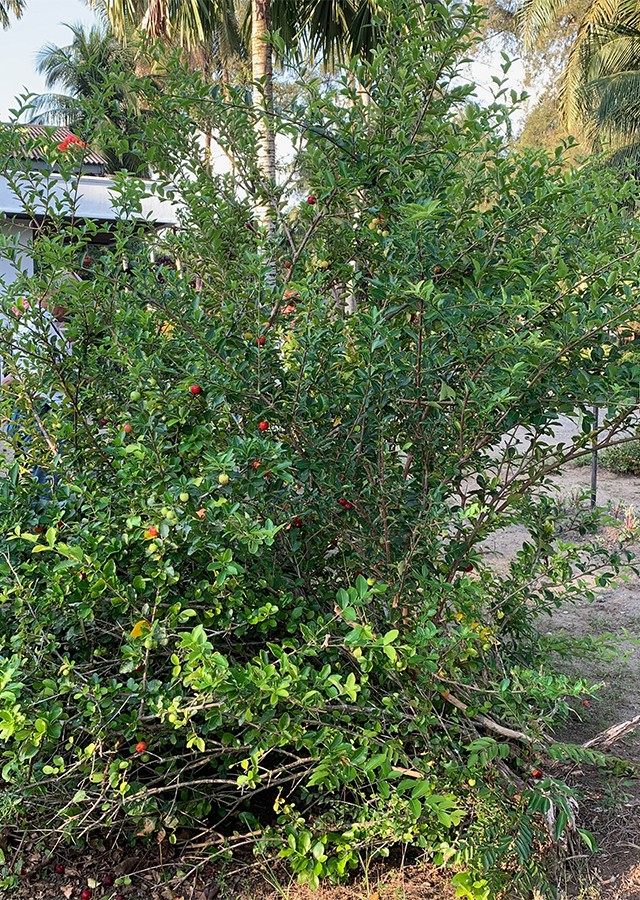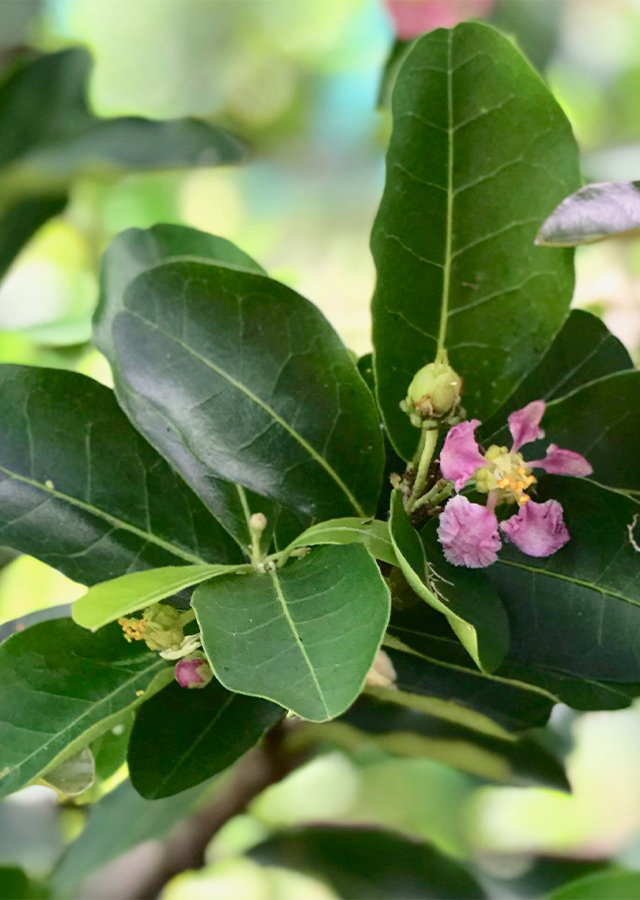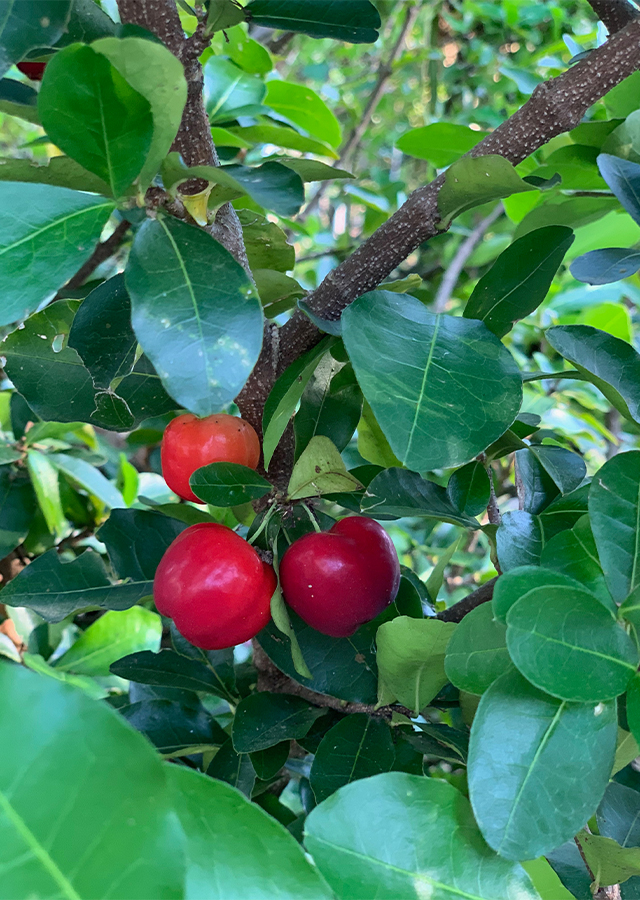Barbados cherry
Malpighia emarginata DC.
Malpighiaceae
Location in our garden
Principal



Synonym
Malpighia berteroana Spreng.
Malpighia lancifolia (Nied.) F.K.Mey.
Malpighia punicifolia var. lancifolia Nied
Habitus
Shrubs. An evergreen shrub growing around 4 m tall
Part Used
Leaves
Fruit
Growing Requirements
Full Sunshine
Habitat
Terrestrial
Overview
This plant is native to the Lesser Antilles and from Northern South America to Southern Texas in the United States. It has been introduced into other parts of the tropics and subtropics. In South-East Asia, it is only sporadically grown. It is also grown as ornaments and for edible fruit.
Vernacular Names
Cerise-antillaise (French), Choeri (Thailand), So'ri (Vietnamese), Xi yin du ying tao (Chinese), Geribde kers (Dutch)
Agroecology
It can be grown almost anywhere in the tropics and warm subtropics. It grows and produces well when rainfall is between 1,200 and 1,600 mm per year. Irrigation is required in areas with little rainfall. Young plants are killed by frost, but mature trees survive brief exposure to -2 °C. The plants tolerate long periods of drought and do not stand waterlogging. The soil should preferably be rich, deep, and well-drained, with a pH above 5.5. On calcareous soils the plants require additional micronutrients, on acid soils, addition of lime is required.
Morphology
- Stem - erect to spreading, slightly rough, grey-brown in colour.
- Leaves - opposite, ovate to elliptic-lanceolate, ranging from 2.5 to 9.0 cm in length and 1.2 to 6.0 cm in width, entire or undulating, dark green and glossy above, petiole short.
- Inflorescences - sessile or short-peduncled axillary cymes with 3-5 flowers.
- Flowers - bisexual, 1-2 cm in diameter, pinkish to reddish, calyx with 6-10 large sessile glands.
- Fruits - a bright-red, juicy drupe, depressed-ovoid, 1-3 cm in diameter and weighing 3-5 g, usually in pairs or threes, obscurely 3-lobed, skin thin, flesh soft, orange, acid to subacid.
- Seeds - 3, triangular, ridged, globose, up to 2.5 cm in diameter.
Cultivation
It can be propagated by seeds and cutting.
Chemical Constituents
Vitamin C, carotenoids phenolics (ß-carotene, ß-cryptoxanthin, lutein and violaxanthin), anthocyanin (cyanidine 3-O-rhamnoside and pelargonidin 3-O- rhamnoside), hydroxycinnamoyl derivatives (caffeoyl hexoside, dihydrocaffeoylquinic acid, and coumaroyl hexoside), niacinamides, bioflavonoids, phenolic, melatonin, tannin, catechins, cardiac glycosides, lactones, steroid, depsides, depsidonas, saponin, quercetin, chlorogenic acid, (−)-epigallocatechin gallate, (−)-epicatechin, procyanidin B1, rutin, and kaempferol
Traditional Medicinal Uses
- Studies have shown antitumor, radioprotective, skin whitening, anti-inflammatory, antioxidant, hypoglycemic, anticarcinogenic, antihyperlipidemic, and insecticidal properties.
- Fruit is commonly used for the treatment of allergic rhinitis, herpes, liver ailments, diarrhea, dysentery, coughs, and colds.
- Fresh fruit is a nutritive aid for managing anemia, tuberculosis, high cholesterol levels, diabetes, rheumatism, and during convalescence.
- Plant juice is used as a gargle for sore throat.
Part Used
Reference Sources
- Belwal, T., Devkota, H.P., Hassan, H.A., Ahluwalia, S., Ramadan, M.F., Mocan, A., and Atanasov, A.G. 2018. Phytopharmacology of Acerola (Malpighia spp.) and its potential as functional food. Trends in Food Science & Technology, 74: 99-106.
- M. Mohammed. 2011. Postharvest Biology and Technology of Tropical and Subtropical Fruits, Chapter 2: Acerola (Malpighia emarginata DC.). Woodhead Publishing Series in Food Science, Technology and Nutrition, pages 27-47, 48e.
- Mezadri, T., Villaño, D., Fernández-Pachón, M.S., García-Parrilla, M.C., Troncoso, A.M. 2008. Antioxidant compounds and antioxidant activity in acerola (Malpighia emarginata DC.) fruits and derivatives. Journal of Food Composition and Analysis, 21(4): 282-290.
- Tropical Plants Database, Ken Fern. tropical.theferns.info/viewtropical.php?id=Malpighia+emarginata. (Accessed on 17-12-2021)

